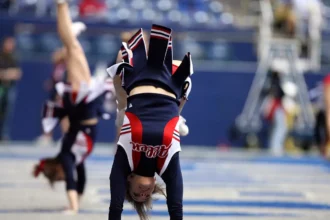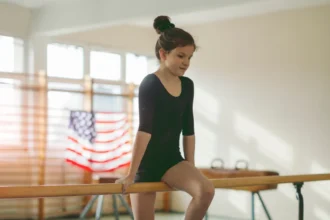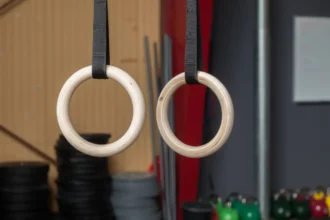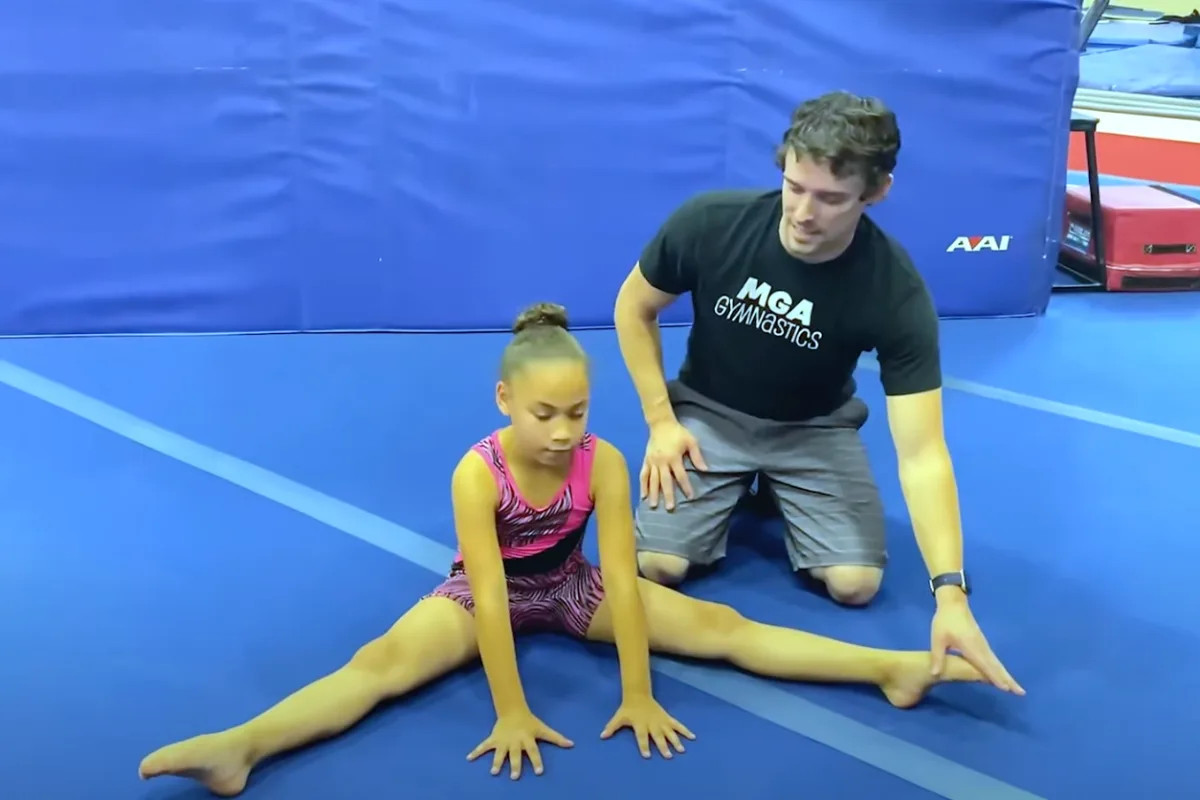In gymnastics, the straddle position refers to a body posture where a gymnast’s legs are spread apart in a wide V shape. This position is essential in a variety of gymnastics routines and exercises across different apparatuses, such as the floor, vault, and bars.
The straddle shape is one of the basic yet versatile positions in gymnastics, often forming the foundation for both simple and complex skills.
Key Straddle Movements in Gymnastics
1. Straddle Sit
The straddle sit is a foundational flexibility position where the gymnast sits on the floor with legs extended outward in a wide straddle. This position enhances flexibility in the inner thighs, hamstrings, and hips. It is commonly used as a starting point for stretching exercises and as a transitional position in routines.
Application: Floor exercises, conditioning routines.
How to do it:
- Sit on the floor with legs extended outward in a wide straddle.
- Keep the back straight and shoulders relaxed.
- Hold the position to stretch the inner thighs and hamstrings.
Note: The straddle sit is often a preparatory position for more advanced flexibility stretches, and it’s frequently used in warm-ups.
2. Straddle Jump
The straddle jump is a dynamic skill where the gymnast jumps into the air, extending the legs outward into a straddle position. This movement adds height and artistry to routines and is commonly performed on the floor and balance beam.
Application: Floor routines, balance beam.
How to do it:
- Initiate the jump with a strong push from the legs.
- Extend the legs outward into a straddle position at the peak of the jump.
- Land softly with control, aiming for a smooth transition into the next movement.
Note: The straddle jump is often used to demonstrate both flexibility and power. In floor routines, it can be paired with other dynamic movements for fluid transitions.
3. Straddle Hold
The straddle hold is a strength and balance exercise where the gymnast maintains a suspended position with legs extended outward in a straddle. This position requires significant core strength and stability.
Application: Floor routines, conditioning programs.
How to do it:
- Begin in a seated position with legs extended outward in a straddle.
- Place hands on the floor beside the hips for support.
- Lift the legs off the ground, keeping them straight and extended.
- Hold the position for a specified duration, focusing on core engagement.
Note: This skill is excellent for building core strength and control, which are essential for more advanced movements.
4. Straddle Back
The straddle back is a skill where the gymnast performs a backward roll or flip while keeping the legs in a straddle position. This movement is commonly performed on the floor and is used to build body control and flexibility.
Application: Floor exercises, conditioning routines.
How to do it:
- Start in a seated position with legs extended outward in a straddle.
- Place hands on the floor behind the hips for support.
- Push off the floor with the hands, lifting the legs over the head.
- Complete the roll or flip, maintaining the straddle position throughout.
Note: The straddle back is useful for teaching gymnasts body awareness during rolls and flips, providing a good foundation for more complex tumbling skills.
5. Straddle Roll
The straddle roll is a basic gymnastics movement where the gymnast rolls forward or backward with legs extended outward in a straddle position. This skill is foundational for teaching body awareness and is useful for beginners to develop strength and coordination.
Application: Floor exercises, conditioning routines.
How to do it:
- Begin in a seated position with legs extended outward in a straddle.
- Place hands on the floor in front for support.
- Tuck the chin and roll forward, keeping the legs extended in a straddle.
- Complete the roll and return to a seated position.
Note: The straddle roll is typically one of the first skills that introduces a gymnast to the concept of rolling, building confidence in body control.
6. Straddle Press to Handstand
The straddle press to handstand is an advanced gymnastics move where the gymnast transitions from a standing or seated straddle position to a handstand without jumping. This skill requires significant core engagement and shoulder stability.
Application: Floor routines, conditioning programs.
How to do it:
- Start in a seated or standing straddle position.
- Place hands on the floor in front, shoulder-width apart.
- Engage the core and press the legs upward, keeping them straight and extended.
- Achieve a handstand position, maintaining control and balance.
Note: This move builds strength in the shoulders and core while promoting balance and control. It’s also great for advanced gymnasts who are working on more fluid transitions into handstands.
7. Straddle Planche
The straddle planche is an advanced gymnastics skill where the gymnast holds a planche position with legs extended outward in a straddle. This move requires significant strength and balance.
Application: Floor routines, conditioning programs.
How to do it:
- Begin in a seated position with legs extended outward in a straddle.
- Place hands on the floor beside the hips for support.
- Engage the core and lift the legs off the ground, keeping them straight and extended in a straddle.
- Hold the position, aiming for a horizontal body line parallel to the floor.
Note: The straddle planche is one of the most challenging static holds in gymnastics, requiring intense strength and balance. It’s typically performed by advanced gymnasts in routines or conditioning.
8. Straddle Split Jump
The straddle split jump is a dynamic movement where the gymnast jumps into the air, extending the legs outward into a straddle position, and then transitions into a split position before landing. This skill combines elements of both the straddle jump and the split jump, showcasing flexibility and control.
Application: Floor routines, balance beam.
How to do it:
- Initiate the jump with a strong push from the legs.
- Extend the legs outward into a straddle position at the peak of the jump.
- Transition into a split position mid-air.
- Land softly with control, aiming for a smooth transition into the next movement.
Note: The straddle split jump demonstrates both flexibility and power. The transition between the straddle and split adds a unique artistic element to floor and beam routines.
Straddle in Different Gymnastics Apparatuses
While the straddle position is common in floor routines, it’s also an essential element in many other apparatuses in gymnastics.
1. Vault: The Straddle-On Technique
In the vault, the straddle position is often seen in the straddle-on technique. This is a basic but important move where the gymnast places their hands on the vaulting table while keeping their legs extended outward in a straddle.
The straddle-on technique is typically used as a mount, helping the gymnast build momentum and transition smoothly into the next phase. It is a key foundational move, especially in beginner and intermediate vaulting routines, as it sets the stage for more dynamic vaults, like Yurchenko or Tsukahara.
2. Uneven Bars: The Straddle Back
On the uneven bars, the straddle back is a fundamental skill. This is where the gymnast swings backward, keeping their legs in a straddle position, to transition from one bar to the next.
The straddle back is often used to move from the low bar to the high bar and is a great way to build momentum while maintaining fluidity in the routine. This skill requires precise timing and control, as the gymnast must coordinate the swing, the straddle position, and the transition all in one motion.
3. Balance Beam: The Straddle-Over Mount
The straddle-over mount is one of the most graceful and elegant ways to start a balance beam routine. In this move, the gymnast jumps from the floor to the beam while extending their legs into a straddle position.
The straddle-over mount is often used by gymnasts in higher-level routines because it requires both technical skill and a good sense of artistry. The straddle position helps to showcase the gymnast’s flexibility, making the transition into the routine smoother and more impressive.
4. Floor Exercise: Straddle Elements in Action
While the straddle isn’t typically used as a mount in floor routines, it’s still an important part of many floor elements. One common skill that uses the straddle position is the straddle-up, where the gymnast lifts their legs into a straddle while seated, then uses their core strength to press into a handstand position.
This move builds strength and flexibility while testing the gymnast’s ability to transition between different body positions. Plus, they look visually appealing when done right, adding to the overall artistry of the floor performance.
In Summary
The straddle position contribute to higher execution scores, add difficulty to routines, and create fluid transitions. Ultimately, the ability to perform and incorporate the straddle position is a crucial skill for gymnasts aiming to compete at higher levels.





